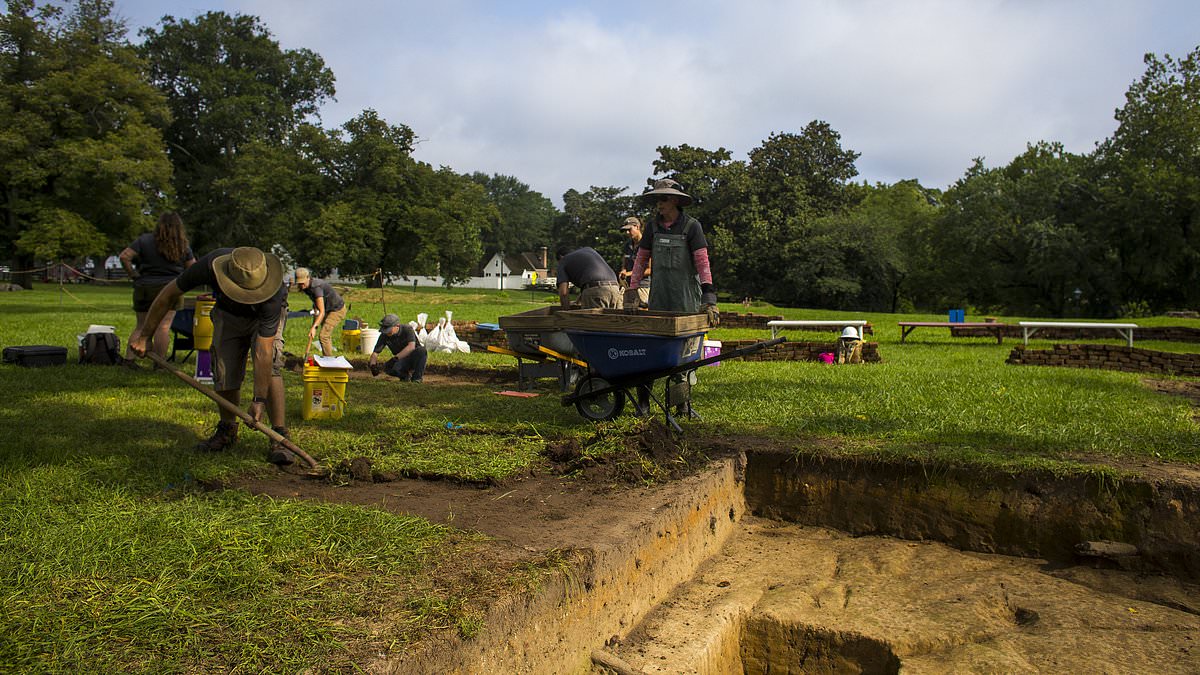Archaeologists in Virginia discovered an opulent colonial era garden where slaves grew exotic plants owned by Martha Washington’s first husband’s family.
The garden in Williamsburg belonged to John Custis IV, a tobacco plantation owner who served in Virginia’s colonial legislature, and the father of Martha Washington’s first husband Daniel Parke Custis.
Custis garden was designed to show of his wealth and the dig determined the garden was about two-thirds the size of a football field.
Experts used Custis’ correspondence with British botanist Peter Collinson to determine his enslaved gardeners tended to exotic plants and guests were greeted with the likes of the crown imperial lily, which was native to the Middle East and parts of Asia.
‘In the 18th century those were unusual things, only certain classes of people got to experience that. A wealthy person today – they buy a Lamborghini,’ said Eve Otmar, Colonial Williamsburg’s master of historic gardening.

Archaeologists in Virginia discovered an opulent colonial era garden where slaves grew exotic plants

The garden in Williamsburg belonged to John Custis IV (pictured) the father of Martha Washington’s first husband Daniel Parke Custis

A preliminary rendering of the reconstructed garden shows topiaries trimmed into balls and pyramids in the garden
A study of the area’s topography placed his garden in direct view of Williamsburg’s only church house at the time.
Descriptions from the time reference lead statues of Greek gods and topiaries trimmed into balls and pyramids in the garden.
Crews dug up fence posts that were three feet thick and carved from red cedar. Gravel paths were uncovered, including a large central walkway, and stains in the soil showed where plants grew in rows.
There also are plans to recreate Custis’ Williamsburg home and garden, known then as Custis Square. Unlike some historic gardens, the restoration will be done without the benefit of surviving maps or diagrams, relying instead on detailed landscape archaeology effort in the museum’s history.
Custis is believed to have made one of Williamsburg’s earliest written mentions of growing tomatoes, known then as ‘apples of love’ and native to Mexico and Central and South America.
Slaves also planted strawberries, pistachios and almonds, among 100 other imported plants. A recent pollen analysis of the soil indicates the past presence of stone fruits such as peaches and cherries.
‘The garden may have been Custis’ vision, but he wasn’t the one doing the work,’ said Jack Gary, executive director of archaeology at Colonial Williamsburg, a living history museum that now owns the property.

Crews dug up fence posts that were three feet thick and carved from red cedar

The dig also has unearthed a pierced coin that was typically worn as a good-luck charm by young African Americans
‘Everything we see in the ground that´s related to the garden is the work of enslaved gardeners, many of whom must have been very skilled.’
The dig also has unearthed a pierced coin that was typically worn as a good-luck charm by young African Americans. Another find is the shards of an earthenware chamber pot, which was a portable toilet, that likely was used by people who were enslaved.
Animals appear to have been intentionally buried under some fence posts. They included two chickens with their heads removed, as well as a single cow´s foot. A snake without a skull was found in a shallow hole that had likely contained a plant.
‘We have to wonder if we’re seeing traditions that are non-European,’ Gary said. ‘Are they West African traditions? We need to do more research. But it´s features like those that make us continue to try and understand the enslaved people who were in this space.’
